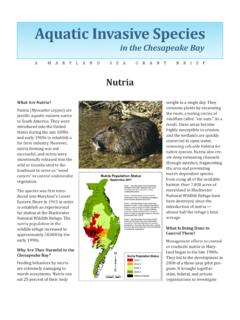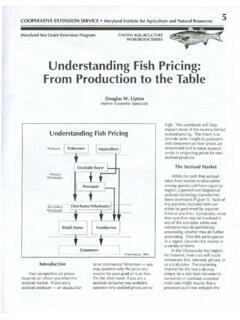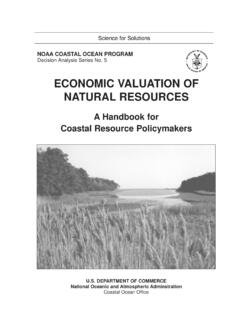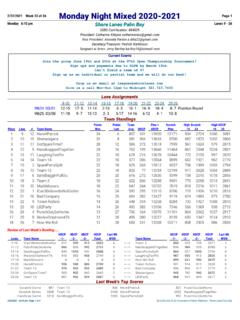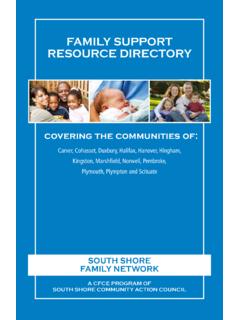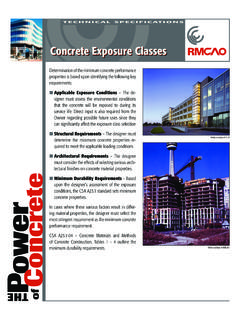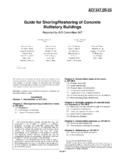Transcription of Aquatic Invasive Species - mdsg.umd.edu
1 What Are Nutria?Nutria (Myocastor coypus) areprolific Aquatic rodents nativeto South America. They wereintroduced into the UnitedStates during the late 1800sand early 1900s to establish afur farm industry. However,nutria farming was notsuccessful , and nutria wereintentionally released into thewild or translocated to theSoutheast to serve as weedcutters to control undesirablevegetation .The Species was first intro duced into Maryland s LowerEastern Shore in 1943 in orderto establish an experimentalfur station at the BlackwaterNational Wildlife Refuge. Thenutria population in thewildlife refuge increased toapproximately 50,000 by theearly Are They Harmful to theChesapeake Bay?
2 Feeding behaviors by nutriaare extremely damaging tomarsh ecosystems. Nutria caneat 25 percent of their bodyweight in a single day. Theyconsume plants by excavatingthe roots, creating circles ofmudflats called eat outs. As aresult, these areas becomehighly susceptible to erosion,and the wetlands are quicklyconverted to open water,removing valuable habitat fornative Species . Nutria also cre ate deep swimming channelsthrough marshes, fragmentingthe area and preventingmarsh dependent speciesfrom using all of the availablehabitat. Over 7,000 acres ofmarshland in BlackwaterNational Wildlife Refuge havebeen destroyed since theintroduction of nutria almost half the refuge s Is Being Done toControl Them?
3 Management efforts to controlor eradicate nutria in Mary land began in the late led to the development in2000 of a three year pilot pro gram. It brought togetherstate, federal, and privateorganizations to investigateAquatic Invasive SpeciesNutriain the Chesapeake BayA MARYLAND SEA GRANT BRIEFand apply the most successful methods. These includesending out teams to track and trap the 2002 the Chesapeake Bay Program (CBP), in part nership with Maryland Sea Grant, sponsored a work shop aimed at developing Baywide managementstrategies for problematic Invasive Species , includingnutria. In 2003 President George W.
4 Bush signed a lawthat provided $20 million over five years for nutriaeradication in Maryland. The CBP the partnershipof federal and state agencies that oversees Bayrestoration efforts concluded that the nutria popu lations needed to be eliminated throughout theChesapeake Bay region, not just in Maryland. The CBPcreated a Chesapeake Bay Nutria Working Group in2003 to develop a Baywide management plan, whichset a target date of 2009 to eradicate the is Their Status?Management efforts have resulted in substantialprogress in controlling the nutria population in theChesapeake region. As of 2004, nutria have been com pletely eradicated from Blackwater National WildlifeRefuge.
5 Intensive surveys conducted throughout theDelmarva Peninsula from 2010 to 2012 indicate thatthe remaining nutria populations are confined toMaryland s Lower Shore in Wicomico and SomersetCounties, primarily in the Wicomico and Manokinrivers. Eradication efforts continue, and resourcemanagers hope to remove the remaining populationswithin a few More InformationChesapeake Bay Nutria Eradication Project ( Fish & Wildlife Service) and Blackwater Refuge ( Fish & Wildlife Service) Invasive Species in the Chesapeake Bay: NutriaMaryland Sea Grant4321 Hartwick Rd., Suite 300 College Park, MD Sea Grant is jointly funded by the state ofMaryland and the National Oceanic and UM SG PI 2013 02 September 2013 This brief was written by Jenny Allen and Daniel Strain; itwas published by Maryland Sea Grant.
6 Photograph and art credits: photograph, Petar Milosevic,Wikimedia Commons; map, Chesapeake Bay NutriaEradication Project: Strategic Plan, produced by the TheNutria Management Team, February 2012
